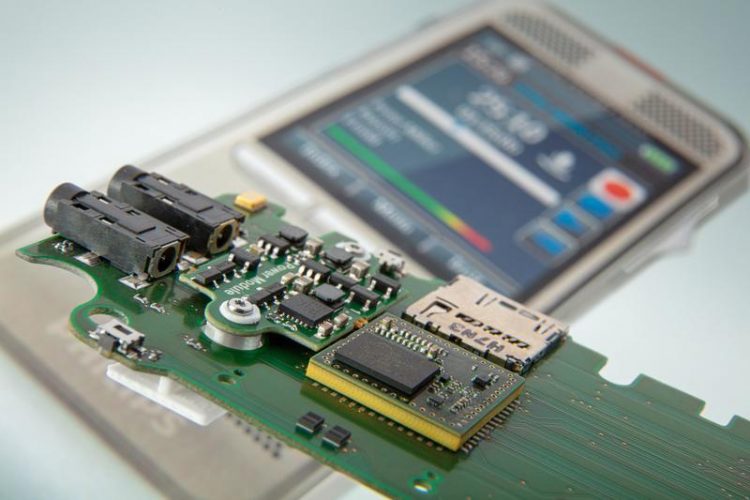What grade do our electronic products get? Life cycle assessment in the electronics industry

Energy consumption during use, repairs and the recycling process is only a fraction of the factors that the researchers at Fraunhofer IZM are investigating as part of life cycle assessments. © Fraunhofer IZM | Volker Mai
Ever more manufacturers and users are interested in the environmental impact that products have. The focus is not only on what a product can do but also on the conditions under which it was manufactured.
This movement is also supported by politics: For example, the “2nd Circular Economy Action Plan” of the European Commission outlines how environmental management and product design must be oriented in the future in order to be as resource-saving and climate-neutral as possible.
Life cycle assessments comprise complex factors and, if possible, all conceivable scenarios. The energy consumption of the appliance is what counts in the evaluation, as well as repairs and maintenance.
When an end product has reached the end of its useful life, recycling processes or disposal can also trigger further environmental impacts to be included in the overall life cycle assessment.
“It is essential to have an understanding not only of the analysis but also of the technologies at stake. Only then can solution-oriented design improvements, suitable indicators and requirements for the supply chain be derived,” emphasises Karsten Schischke, expert for environmental assessment and ecodesign at the Fraunhofer Institute for Reliability and Microintegration IZM.
Schischke and his team have taken on the challenge posed by the fact that hardly any data on the service life and utility of new products is known.
Fraunhofer IZM is qualified to perform such analyses for companies as an independent third-party due to its many years of expertise in the field of microelectronics. Based on the relevant ISO standards for life cycle assessment and environmental management*, researchers at Fraunhofer IZM evaluate and verify the life cycle assessments of third-parties and contribute, above all, to the ecological optimisation of products and processes. They indicate which substances need to be substituted or which processes need to be changed.
However, preparing a life cycle assessment is not a five-minute process. By way of example: As part of an assignment, Fraunhofer IZM experts were tasked with drawing up a life cycle assessment for the sustainably developed smartphone called Fairphone. The trick behind this smartphone: Several components are modular, meaning that they can be easily replaced in case of failure.
Users are thus encouraged to have the Fairphone repaired instead of buying a new one. The multi-layered study by Fraunhofer IZM showed that despite a sustainable product design, the Fairphone initially causes greater environmental impact during production because more individual components are initially produced for the modular composition.
If this modularity, in turn, contributes to a longer service life for the overall product, the impact then becomes positive. Whether this also applies to the successor generation – the Fairphone 3 – will be presented at the upcoming virtual conference Electronics Goes Green , which is organised by Fraunhofer IZM and will be live from August 20.
At the established sustainability conference, the environmental aspects of modular equipment will also be the subject of a whole block of topics, which will examine not only the life cycle assessments of electronic products but also the various technology systems.
Schischke summarises his work with these words: “The better product is the goal, not necessarily the perfect assessment,” and adds: “LCAs are dynamic: reparability, modularity and product design – all factors should be considered from day one to create a more sustainable product”.
Furthermore, the calculation of greenhouse gas emissions at European level can still have far-reaching effects if a CO2 tax is introduced as announced: For this purpose, greenhouse gas emissions that arise during production, i.e. in the upstream chains of imported goods, are to be priced.
Schischke and his team see great potential in environmental assessment despite the challenges: “Climate neutrality is already a real goal for many companies. However, many companies only focus on the effects of their own production and energy consumption. It is at least as important to look at the supply chain in order to procure only climate-neutral components in the medium- and long-term.”
1 https://electronicsgoesgreen.org/
*ISO 14040, 14044, 14064-3 compliant https://www.iso.org/iso-14001-environmental-management.html
Karsten Schischke l Phone +49 30 46403- 156 l karsten.schischke@izm.fraunhofer.de |
Fraunhofer Institute for Reliability and Microintegration IZM I Gustav-Meyer-Allee 25 | 13355 Berlin | www.izm.fraunhofer.de |
https://www.izm.fraunhofer.de/en/news_events/tech_news/what-grade-do-our-electro…
https://www.izm.fraunhofer.de/en/abteilungen/environmental_reliabilityengineerin…
Media Contact
All latest news from the category: Power and Electrical Engineering
This topic covers issues related to energy generation, conversion, transportation and consumption and how the industry is addressing the challenge of energy efficiency in general.
innovations-report provides in-depth and informative reports and articles on subjects ranging from wind energy, fuel cell technology, solar energy, geothermal energy, petroleum, gas, nuclear engineering, alternative energy and energy efficiency to fusion, hydrogen and superconductor technologies.
Newest articles

Machine learning algorithm reveals long-theorized glass phase in crystal
Scientists have found evidence of an elusive, glassy phase of matter that emerges when a crystal’s perfect internal pattern is disrupted. X-ray technology and machine learning converge to shed light…

Mapping plant functional diversity from space
HKU ecologists revolutionize ecosystem monitoring with novel field-satellite integration. An international team of researchers, led by Professor Jin WU from the School of Biological Sciences at The University of Hong…

Inverters with constant full load capability
…enable an increase in the performance of electric drives. Overheating components significantly limit the performance of drivetrains in electric vehicles. Inverters in particular are subject to a high thermal load,…





















